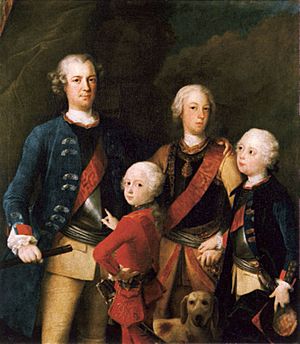Frederick William I of Prussia facts for kids
Quick facts for kids Frederick William I |
|
|---|---|

Portrait by Antoine Pesne, c. 1733
|
|
| King in Prussia Elector of Brandenburg |
|
| Reign | 25 February 1713 – 31 May 1740 |
| Predecessor | Frederick I |
| Successor | Frederick II |
| Born | 14 August 1688 Berlin, Brandenburg-Prussia |
| Died | 31 May 1740 (aged 51) Berlin, Kingdom of Prussia |
| Burial | Friedenskirche, Sanssouci Park, Potsdam |
| Spouse | |
| Issue |
|
| House | Hohenzollern |
| Father | Frederick I |
| Mother | Sophia Charlotte of Hanover |
| Religion | Calvinist |
| Signature |  |
Frederick William I (German: Friedrich Wilhelm I.; born August 14, 1688 – died May 31, 1740) was a powerful ruler known as the "Soldier King." He was the King in Prussia and Elector of Brandenburg from 1713 until his death. He also ruled as the Prince of Neuchâtel. His son, Frederick the Great, became king after him.
Contents
Early Life and Influences
Frederick William I was born in Berlin. His parents were King Frederick I of Prussia and Princess Sophia Charlotte of Hanover. A French governess, Marthe de Roucoulle, looked after him when he was very young.
During his youth, a terrible plague hit Prussia. This showed how inefficient and corrupt the king's top officials were. Frederick William joined a group at court that worked to remove the main minister, Johann Kasimir Kolbe von Wartenberg. An investigation proved Wartenberg had stolen a lot of money. This event deeply affected Frederick William. He began to dislike corruption and waste. He realized that the government needed big changes. This was also the first time he got involved in politics. After this, his father, King Frederick I, started giving him more power.
Becoming King and Improving Prussia
Frederick William I became king in 1713. His father had worked hard to get the title of king for the rulers of Brandenburg. As king, Frederick William I focused on making Prussia stronger in both its economy and its military.
Economic and Military Changes
He made many improvements. He changed the rule that required middle-class people to serve in the military. Instead, they paid an annual tax. He also started new schools and hospitals. The king encouraged farming and drained swampy lands to create more farmland. He stored grain when harvests were good and sold it when times were tough.
Frederick William I wrote a detailed rulebook for all government workers. It had 35 chapters and 297 paragraphs. Every public servant knew exactly what their job was. For example, a minister who missed a meeting would lose six months' pay. If they missed a second time, they would be fired. He was very involved in every part of his country. He ruled as an absolute monarchy, meaning he had complete power. He did this with great energy and skill.
Prussian Colonies and Trade
The king also paid attention to Prussia's colonies. In 1717, he canceled the charter of the Brandenburg Africa Company (BAC). This company had been given permission by his father to set up a colony in West Africa. The colony was called the Brandenburg Gold Coast. The company had used it to transport enslaved Africans to the Americas.
Frederick William I did not want to spend money on keeping the colony or the Prussian Navy. He preferred to use state money to make the Royal Prussian Army bigger. In 1721, he sold the Brandenburg Gold Coast to the Dutch West India Company. In return, he received money and 12 enslaved African boys.
Helping Protestants Settle
In 1732, the king invited Protestants from Salzburg to move to East Prussia. This area had lost many people due to the plague in 1709. A peace agreement allowed Protestants to move to a Protestant state if their ruler wanted them to practice the Catholic faith. Prussian officials helped 20,000 Protestants travel across Germany to their new homes. Frederick William I personally welcomed the first group and sang hymns with them.
Building a Strong Army
Frederick William briefly joined the Great Northern War with Russia. He gained a small part of Swedish Pomerania, which gave Prussia new ports on the Baltic Sea. More importantly, he made huge changes to the Prussian army. With help from his friend Prince Leopold of Anhalt-Dessau, he improved training, tactics, and how soldiers were recruited. He introduced the canton system. He also made the infantry's guns fire faster by using iron ramrods.
Frederick William's changes meant his son, Frederick, inherited the strongest army in Europe. Frederick used this army to make Prussia even more powerful.
His Personality and Health
Even though he was a very effective ruler, Frederick William often had a short temper. He sometimes hit servants or even his own children with a cane if he felt they had done something wrong. He also had a health condition that caused him to have gout, be overweight, and suffer from frequent stomach pains. He strongly disliked France, but this did not stop him from welcoming French Huguenot refugees to Prussia.
Burial and Reburials
Frederick William I died in 1740 when he was 51 years old. He was first buried at the Garrison Church in Potsdam. During World War II, to keep his coffin safe from advancing armies, it was moved. First, it went to Berlin, then to a salt mine. American forces found the coffins and reburied them in St. Elisabeth's Church in Marburg in 1946.
In 1953, the coffin was moved again to Burg Hohenzollern. It stayed there until 1991. Finally, it was laid to rest on the altar steps in the Kaiser Friedrich Mausoleum at the Church of Peace in Sanssouci. The original black marble coffin was damaged, so the current one is a copper copy.
Relationship with Frederick II
His oldest son who survived was Frederick II (nicknamed Fritz), born in 1712. Frederick William wanted Fritz to be a great soldier. When Fritz was a small child, he was woken up by a cannon firing every morning. At age 6, he was given his own group of children to train as cadets. A year later, he received a tiny collection of weapons.

Frederick William loved his son at first, but their different personalities soon caused problems. Frederick William wanted Fritz to have a simple education, live a plain Protestant life, and focus on the army and government, just like him. However, Fritz was more interested in music, books, and French culture. His father saw these interests as bad and unmanly, and he forbade them.
As Fritz disobeyed his father more, Frederick William often hit or shamed him. He preferred his younger son, Augustus William. Fritz was even beaten for falling off a horse and for wearing gloves in cold weather.
Fritz tried to run away to England with his tutor, Hans Hermann von Katte. The king was furious. He had Katte beheaded right in front of Fritz. Fritz himself faced a military trial. The court said it couldn't judge a prince. It's not clear if the king wanted his son executed too. However, the Holy Roman Emperor stepped in, saying a prince could only be tried by the Imperial Diet. Frederick was imprisoned for a few months. During this time, he was strictly taught about government matters.
After they made up a bit, Frederick William arranged for his son to marry Princess Elisabeth Christine of Brunswick-Wolfenbüttel-Bevern. Frederick disliked her. But his father then allowed him to enjoy his music and books again. He also gave him a horse farm and a palace. By the time Frederick William died in 1740, he and Frederick were on fairly good terms.
Even though their relationship was difficult, Frederick later wrote that his father "understood great goals, and knew the best interests of his country better than any minister or general."
Marriage and Family
Frederick William married his cousin, Sophia Dorothea of Hanover, on November 28, 1706. She was the younger sister of George II. Frederick William was loyal and loving to his wife, but their relationship was not happy. Sophia Dorothea was afraid of his unpredictable temper. She also disliked that he gave her no power or freedom at court. She was upset that he refused to let their children marry their English cousins. She also hated his cruelty towards their son Frederick, whom she was close to. Instead of helping them, she often encouraged Frederick to defy his father. They had fourteen children.
| Name | Portrait | Lifespan | Notes |
|---|---|---|---|
| Frederick Louis Prince of Prussia |
 |
23 November 1707- 13 May 1708 |
Died as a baby |
| Friedrike Wilhelmine Margravine of Brandenburg-Bayreuth |
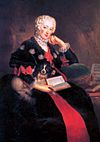 |
3 July 1709- 14 October 1758 |
Married Frederick, Margrave of Brandenburg-Bayreuth and had children |
| Frederick William Prince of Prussia |
 |
16 August 1710- 21 July 1711 |
Died as a baby |
| Frederick II the Great King of Prussia |
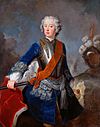 |
24 January 1712- 17 August 1786 |
King in Prussia (1740–1772); King of Prussia (1772–1786); married Elisabeth Christine of Brunswick-Wolfenbüttel-Bevern but had no children |
| Charlotte Albertine Princess of Prussia |
 |
5 May 1713- 10 June 1714 |
Died as a baby |
| Frederica Louise Margravine of Brandenburg-Ansbach |
 |
28 September 1714- 4 February 1784 |
Married Charles William Frederick, Margrave of Brandenburg-Ansbach and had children |
| Philippine Charlotte Duchess of Brunswick-Wolfenbüttel |
 |
13 March 1716- 17 February 1801 |
Married Charles I, Duke of Brunswick-Wolfenbüttel and had children |
| Louis Charles William Prince of Prussia |
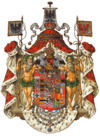 |
2 May 1717- 31 August 1719 |
Died as a young child |
| Sophia Dorothea Margravine of Brandenburg-Schwedt Princess in Prussia |
 |
25 January 1719- 13 November 1765 |
Married Frederick William, Margrave of Brandenburg-Schwedt, Prince in Prussia and had children |
| Louisa Ulrika Queen of Sweden |
 |
24 July 1720- 2 July 1782 |
Married Adolf Frederick, King of Sweden and had children |
| Augustus William Prince of Prussia |
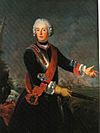 |
9 August 1722- 12 June 1758 |
Married Duchess Luise of Brunswick-Wolfenbüttel and had children (including Frederick William II) |
| Anna Amalia | 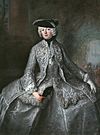 |
9 November 1723- 30 March 1787 |
Became the head of a religious community (Abbess of Quedlinburg) on July 16, 1755 |
| Frederick Henry Louis Prince of Prussia |
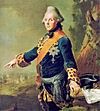 |
18 January 1726- 3 August 1802 |
Married Princess Wilhelmina of Hesse-Kassel but had no children |
| Augustus Ferdinand Prince of Prussia |
 |
23 May 1730- 2 May 1813 |
Married Margravine Elisabeth Louise of Brandenburg-Schwedt and had children |
Frederick William I was also the godfather to the Prussian envoy Friedrich Wilhelm von Thulemeyer and his grand-nephew, Prince Edward Augustus of Great Britain.
See also
 In Spanish: Federico Guillermo I de Prusia para niños
In Spanish: Federico Guillermo I de Prusia para niños
- Prussian virtues



